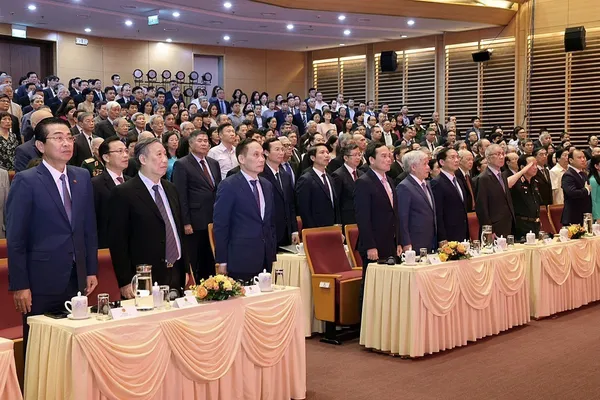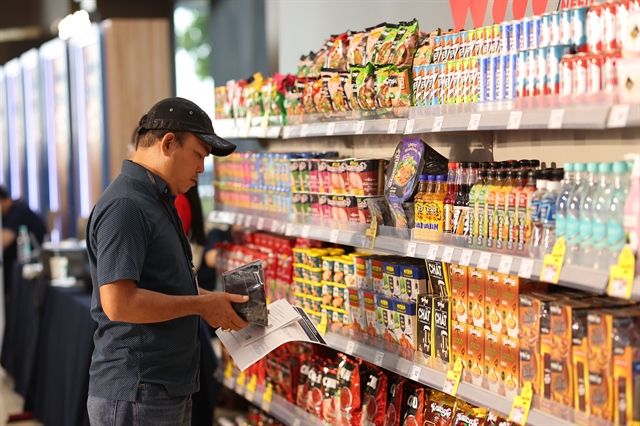 Society
Society

The 2015 Migration Survey provides critical data for the government to create and manage sound evidence-based policies and plans to address the current and future needs of migrants.
 |
| Rural workers from Hà Nội’s suburbs and other provinces poured into the capital city for better opportunities of livelihood, a large portion of them work as vendors roaming the city’s streets. These migrant workers will need special attention and management from all levels of authority. - VNS Photo Đoàn Tùng |
By Thu Trang
HÀ NỘI – Fifty-year-old Lê Thị Lành gets up at 5.30am everyday to prepare sticky rice to sell on the pavement of Hà Nội’s Trung Liệt Street.
Coming from Đại Thắng Commune, Phú Xuyên District in Hà Nội, she has sold sticky rice in Đống Đa District, one of the capital city’s main districts, for more than 20 years.
“I missed my children so much at first, especially my youngest daughter. Every time I left for work in central Hà Nội, she cried and begged me to stay,” said Lành.
“I fought my tears and told her that I would be away only for a little while and back really soon,” she said.
Lành started selling sticky rice in 1994. Before, she grew rice in her hometown, but income from the work did not provide enough for her three children’s schooling and her family’s daily life.
“Seeing children in the village leaving for university, I dreamt that my own children could do the same one day. It drove me to move somewhere and kept me going when times were tough,” she said.
Lành is among a great number of migrant-workers in Hà Nội in particular, and in Việt Nam in general.
Việt Nam has undergone a significant transition over the last three decades. 13.6 per cent of Vietnamese citizens over the past five years have been migrants. Approximately 19.7 per cent of the urban population are migrants, where the figure is only 13.4 percent of the rural population. The Southeast region has the highest proportion of migrants at 29.3 per cent.
These findings were disseminated at the national workshop on the results of the 2015 national internal migration survey, held yesterday in Hà Nội by the General Statistics Office (GSO) and the United Nations Population Fund (UNFPA) in Việt Nam.
The 2015 National Internal Migration Study was conducted in 20 provinces and centrally-run cities representing the country’s six socio-economic regions, and in the two largest cities of Hà Nội and HCM City. This is the second national internal migration survey conducted by the General Statistics Office. The first survey was conducted in 2004.
According to the final results, female migrants make up 17.7 per cent of the female population aged 15-59; this figure for male migrants is 16.8 per cent.
Nguyễn Bích Lâm, GSO general director, said that migrants, especially temporary ones, often meet several obstacles. Migrants often lack access to basic social services and cannot become part of the host communities in their destinations in a way that allows them to fully participate in local social and economic activities.
According to the survey data, of all difficulties faced by migrants, housing is most common.
42.6 per cent of migrants reported that they have housing problems. Migrants are more likely to seek support from family members, relatives and friends, rather than the local authorities, organisations and unions in destination areas.
Lành said that when she first came to Hà Nội, she had to spend a lot of time and efforts to find an accommodation. Cheap houses were too far whereas the nearer options were too expensive for her budget.
At last, she shared a small room no more than 10sq.m with two other people, priced at some thousands of đồng per person per night.
More than 30 per cent of migrants sent earnings back to their family within the 12 months prior to the survey, with female migrants slightly more likely to remit than were male migrants, a difference of 30.8 per cent versus 29.2 per cent.
Although female migrants are more likely than males to send remittances, the total amount of remittances sent by male migrants is higher. Up to 41.5 per cent of male migrants sent remittances in cash and in kind worth more than VNĐ6 million (US$260) and above compared to the 34.7 per cent of female migrants.
Lành said that every day she earned about VNĐ200,000 ($8). After deducting expenses, she could send about VNĐ4 million ($170) to her hometown.
General director Lâm said, “To address these challenges against migrants, over the last decade, Việt Nam has made great efforts to raise awareness about migration issues among policy makers and to support migrants in ensuring their basic rights and social security needs are met.”
Migrants have been both the consequence and the key driving force behind Việt Nam’s socio-economic development, but so far their contributions have not been fully recognised.
“The findings of the survey are excellent evidence that can be used to provide the basis for formulation of policies on socio-economic development in general and migrants in particular,” he said.
Astrid Bant, UNFPA Representative in Việt Nam, said, migration must be included in the socio-economic development policies and plans at all levels.
It is especially important in the context that Việt Nam is in the process of implementating the recently approved 2016-20 Socio-Economic Development Plan and the National Action Plan to implement the 2030 Agenda for Sustainable Development,” she said.
The 2015 Migration Survey provides critical data for the government to create and manage sound evidence-based policies and plans to address the current and future needs of migrants. Therefore, GSO may consult with relevant ministries and Government Office to add the Migration Survey to the list of Vietnamese surveys to request research resources.
“The results of the 2015 Migration Survey help us better understand the impacts of internal migration in Việt Nam and will hopefully identify key changes needed in policies and practices to provide more options for the migrants--especially the poor and vulnerable--so that they, and society as a whole, can benefit from voluntary economic migration,” she said.
Now Lành’s children have all grown up and graduated. One graduated with a degree in education, one in banking and the youngest one from a vocational training college. And she still works hard with hope for a better living condition.
“My husband and I may not be better off, but seeing our children growing up and studying hard makes me happy,” she said.
“I’m growing old now. I’m trying to work and save money for retirement and to pay for healthcare,” she said. – VNS









